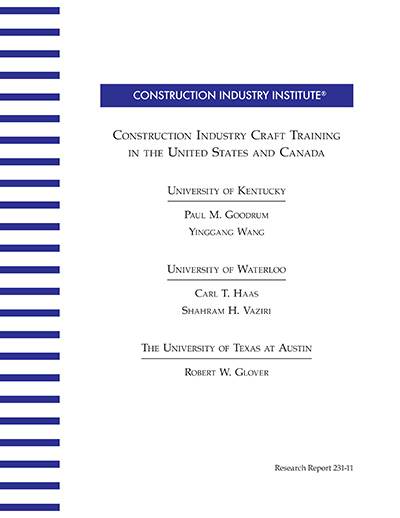
Construction Industry Craft Training in the United States and Canada
Enhanced craft training is where safety training was 15 years ago. Safety improvements garnered much attention then, and efforts to improve the skills of the industry’s work force are now receiving similar attention. Improving safety resulted in large payoffs, and continuing to emphasize safety is the right thing to do. Evidence exists that craft training pays off just as well.
CII established the Construction Industry Craft Training Research Team to examine construction craft training. The team concludes that each dollar invested in craft training can yield $1.30 to $3.00 in benefits. The benefits accrue in the form of increased productivity and reductions in turnover, absenteeism, rework, and other areas.
Since the 1980s, the average age of craft workers has continued to climb. Currently, real wages are rising rapidly and could attract new entrants, who unfortunately may stay only briefly. Craft training will be one major way to retain these new entrants in the construction profession and make them fully productive.
A large body of evidence shows that construction craft training can be effective in a broad range of circumstances. The research presented here shows that the business case for craft training improves the longer craft workers are engaged in training.
Some owners have begun requiring craft training and certification for all craft workers. Current shortages of certified workers are driving up wages, which will attract new craft workers to enter the profession. These new workers will need training in construction basics and will benefit greatly from mentoring and formal on-the-job training programs. When new craft workers recognize that efforts on their part to obtain training pay off in higher wages, they will make the sacrifices necessary to move ahead.
This CII study received financial support from the Construction Users Round Table (CURT) and the National Center for Construction Education and Research (NCCER).
Number of factors for training resistance that would lead to a future supply of adequate craft:
- Reluctance to lose a bid due to added training cost
- Reluctance to train and then possibly lose trained craft workers to competitors
- Reluctance to invest in unproven training programs
- Reluctance to address the general need for training, since craft workers can be attracted from competitors
- Lack of employee acceptance of formal training programs
- Lack of ability to quantify the improved productivity and other benefits that can be realized through training
Organizations are not measuring craft training effectively using data they already collect. But the benefits of craft training can be seen in the data of: (RS231-1, p. 6)
- Absenteeism rate: the rate of occurrence of absence from work or duty
- Turnover rate: the rate of the number of craft workers hired by a company/project to replace those who have left voluntarily in a given period of time
- OSHA recordable rate: the rate, per 100 craft workers, of the number of times per year a craft worker received treatment beyond basic first aid for an a occupational injury or illness
- Rework rate: the amount of rework, waste and off-quality product produced during a project or within a company during a given period of time
- Labor productivity rate: the amount of craft hours used to complete a given quantity of work
RS231-1, Training Best Practices Checklists
Checklists have been provided (owner, employer, trainee, and journeyman) to serve multiple purposes but most notably, they help each stakeholder achieve an optimal learning environment for improved project performance (RS231-1, p. 30)


